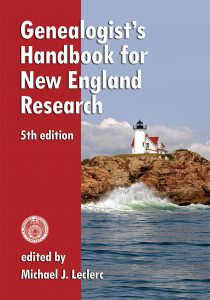 In August I had the pleasure of conducting a webinar entitled “Top 10 Published Resources for Early New England Research.” Given the tremendous genealogical interest in this time period and for this geographic area, I thought Vita Brevis readers might enjoy a series of posts based on the content of the webinar.
In August I had the pleasure of conducting a webinar entitled “Top 10 Published Resources for Early New England Research.” Given the tremendous genealogical interest in this time period and for this geographic area, I thought Vita Brevis readers might enjoy a series of posts based on the content of the webinar.
This first post on the topic addresses the criteria for being considered a top resource and includes a synopsis of one of the “Top 10s” on our list. Future posts will include the other publications on the “Top 10” list and conclude with an Honorable Mention list.
The Criteria
The criteria for making the Top 10 includes one or more of the following:
- It is a scholarly publication that has been prepared by an author or team that is vetted and highly regarded in the field;
- When a publication has genealogical content, the narrative and sketch material has been created through exhaustive research for primary sources and includes citations to the sources; and
- When it is a handbook or guidebook, it supports effective, reliable, and efficient research.
While there is a certain degree of subjectivity when creating a top 10 list of any kind, I think there is a core collection of published resources that a majority of genealogists would consider go-to resources for early New England research. In no particular order, the first publication that will be discussed is...
Genealogist’s Handbook for New England Research, 5th ed., edited by Michael J. Leclerc.
This handbook is an essential resource for understanding the formation of counties and towns within the New England states, as well as where the records were created and held during different time periods. The first chapter provides a general overview about researching and record keeping in New England, including information and sources for Great Migration-era research, as well as the unique geopolitical subdivisions within New England. There is a helpful list of significant regional repositories, as well as a list of genealogical societies that can be found in the area.
One of the features that makes this book easy to use is the colored edge to the pages which indicate the start and end of each state chapter. Within each chapter you will find:
- Statewide maps showing county boundaries and county maps showing town boundaries.
- Dates of incorporation including parent county and daughter county.
- Lists of major repositories with significant regional or statewide collections.
- Standardized information in town tables across all states.
- An essay for each state which includes the essential genealogical resources:
- Vital records
- Church records
- Probate records
- Land records
- Court records
- Military records
- State census, immigration records
Each state’s chapter includes a map of the state with the current county boundaries identified, and a listing of the major repositories that hold significant regional or statewide collections. This list includes archives, libraries, historical societies, and museums, and provides helpful contact information for each repository. Each state also has a section with a quick reference guide to the contact information for probate and land records collections.
Within each state there is a page that lists the counties as well as any extinct counties. The county list includes information on the year the county was established, if it came from a parent county, where the probate district(s) and deed district(s) will be found, and any notes that may be important. An example of a note can be found in Maine: York County, established in 1652 and called Yorkshire 1658–91.
When your research requires records created at the county level, this type of information is very helpful in determining the correct place to search for a particular time-period and place.
The counties are then treated individually and organized alphabetically. Each county section includes a map of the county within the state, and a map of the county with the town boundaries. Included is the year the county was established, the parent counties, where the county seat is located, a list of all the towns within the county, and a list of all extinct or unincorporated towns. When your research requires records created at the county level, this type of information is very helpful in determining the correct place to search for a particular time-period and place.
Finally, there is a town section that provides a detailed list of each town in alphabetical order. Included is the year of incorporation, the county the town belongs to, the parent town (if there was one), the daughter towns (if there are any), any notes applicable to the town, and where vital records or church records are held – such as on a microfilm at NEHGS or in a published volume. There is also a separate list of extinct or unincorporated towns.
Understanding when a town was incorporated and what the parent town is can be extremely helpful when searching for records. For example, Freedom, New Hampshire was incorporated in 1831 from Effingham. Effingham was granted in 1749 and called Leavitstown until 1778. Therefore, if you are researching a family found in the 1850 Federal census for Freedom, the same family may be found in the 1830 Federal census for Effingham, and that same family (or their ancestors) may be found in records associated with Leavitstown between 1749 and 1778.
Overall, I find this handbook to be essential for establishing a timeline for an area before my research even begins. It is definitely one of my go-to resources.
To be continued.
Share this:

About Tricia Mitchell
Tricia Healy Mitchell is a genealogist at the New England Historic Genealogical Society and a graduate of the Boston University Certificate program in Genealogical Research. Her areas of experience and research interests include New York, Maine, Massachusetts, and Ireland. She authored the Portable Genealogist: Probate Records and she is a member of the team offering lectures and webinars at the American Ancestors Research Center and at AmericanAncestors.org. She holds a Bachelor of Science degree in business from the University of Maine.View all posts by Tricia Mitchell →